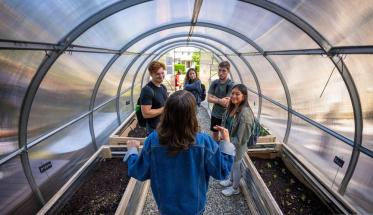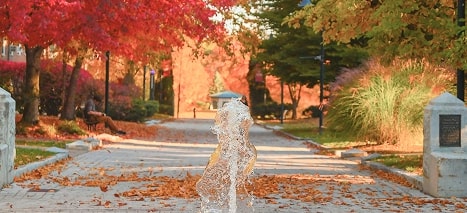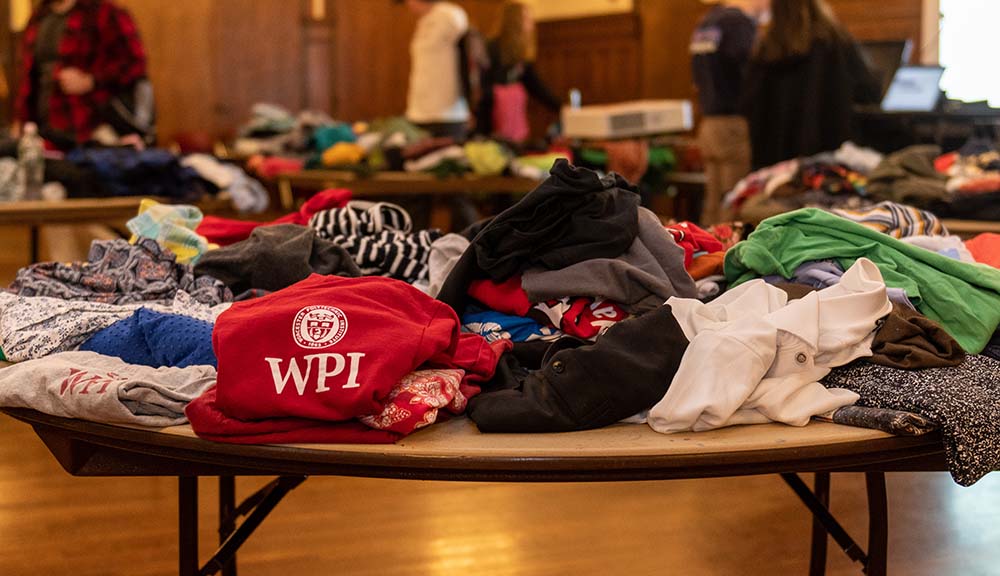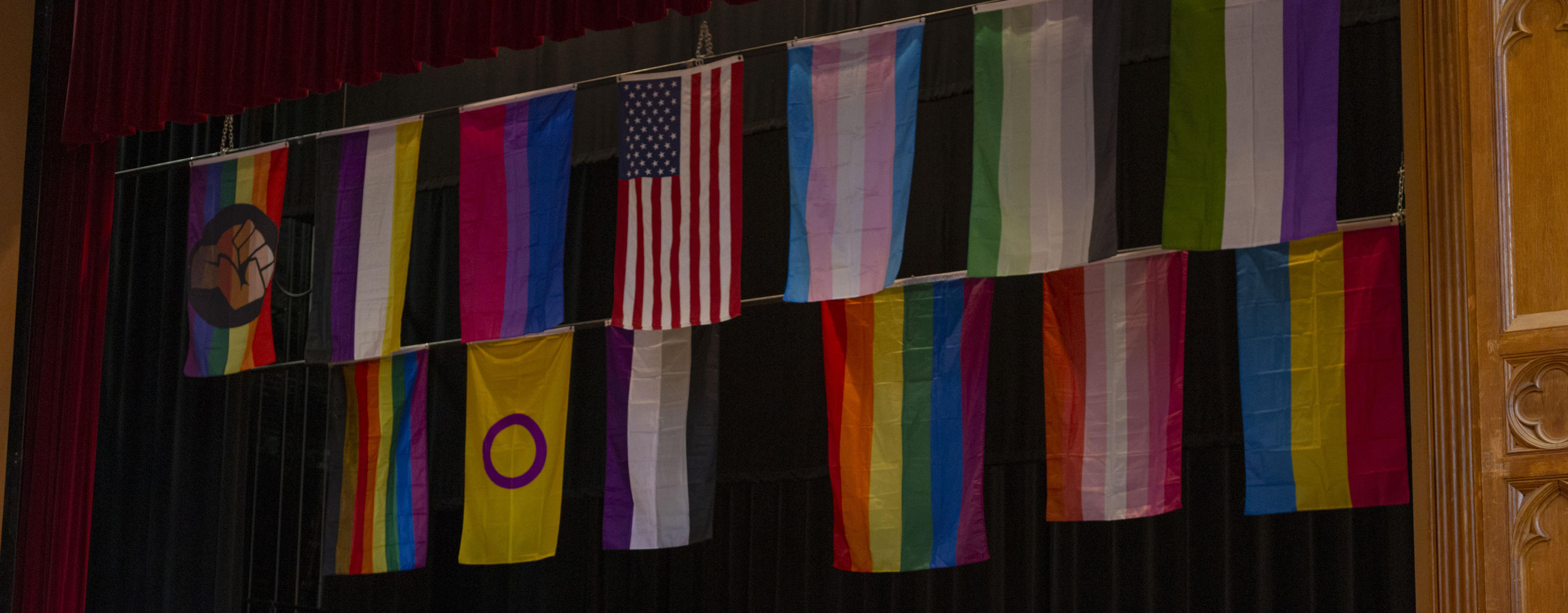Inch by inch, row by row, WPI’s Green Team is helping the campus community grow.
A new greenhouse at 19 Schussler Road, beside the Collegiate Religious Center (CRC), is the first visible piece of the club’s plans to cultivate a vibrant community garden for WPI students, faculty, and staff.
“We want this to be not only a garden, but a community space where people can come and spend time and learn from each other,” says Gabriel Espinosa, Green Team’s president and a senior mechanical engineering major.
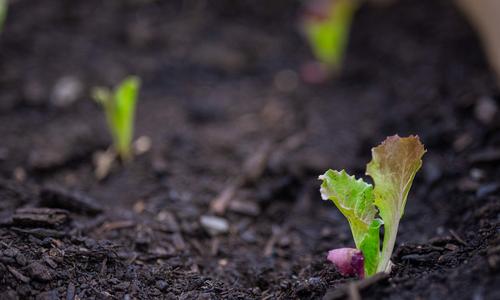
Young lettuce plants in the community garden
About 100 people stopped by during last month’s open house marking the official launch of the community garden. Many of those present had already lent some sweat equity to the project, which is one of the tasks specified in WPI’s sustainability plan and has been more than a year in the making. During the planning process Green Team leaders developed relationships across campus—in particular with the Facilities Office, the Office of Diversity, Inclusion, and Multicultural Education (ODIME), and Dining Services.
“Facilities has been with us on pretty much every step of this. But we also wanted to make sure we weren’t putting more work on them by creating this space,” says Paige Agostini, chair of Green Team’s community garden subcommittee and a junior double majoring in chemical engineering and environmental studies.
Construction of an accessible walkway and patio at the CRC, which is part of ODIME, was already underway when Green Team got the university’s approval to use the side yard for a garden. The club’s advisor, Nicole Luiz ’18, is the energy and sustainability manager in the Facilities Office and Office of Sustainability and has been instrumental in making the greenhouse a reality.
Sowing Stewardship
Even though Green Team isn’t officially affiliated with the CRC, the club’s focus on sustainability and environmental justice dovetails with ODIME’s focus on multicultural community building. That connection became clear to both Agostini and Espinosa when they took courses with Joseph Cullon, professor of teaching in the Department of Humanities & Arts.
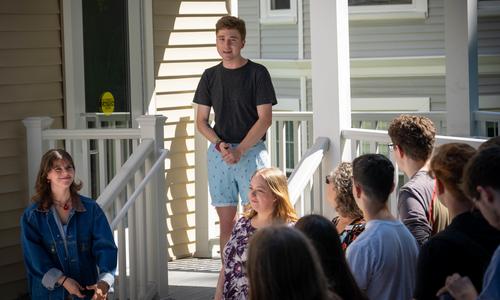
Gabriel Espinosa welcomes people during community garden open house
“Through industrialization, we’ve polluted a lot of the soil around us, particularly in marginalized communities,” says Espinosa. “In Professor Cullon’s classes he emphasizes that giving people control over a piece of land, where they can grow things and reap the rewards, is a great way to give a voice and power to communities that have traditionally been left out of conversations.”
Noting that Worcester’s industrial past means much of the city is likely a brownfield, Agostini adds, “While WPI may be in a privileged part of the city, we hope the community garden gets people thinking about environmental justice.”
Kalvin Cummings, ODIME’s assistant director for religion and spiritual life, is happy that the community garden is housed at the CRC.
“Faith organizations have always lent their physical spaces to the needs of the community. As the university’s primary interfaith space, the CRC is a natural place to put community efforts into action,” says Cummings.
Cultivating Connections
In total, launching the community garden cost just over $6,000 and was paid for entirely by the Student Government Association. That covered the purchase of the greenhouse structure itself, plus seeds and gardening tools, as well as pouring the foundation and other site preparation steps. Green Team members built the six raised beds, which are filled with soil and compost donated by the Greenhouse & Horticulture Club.
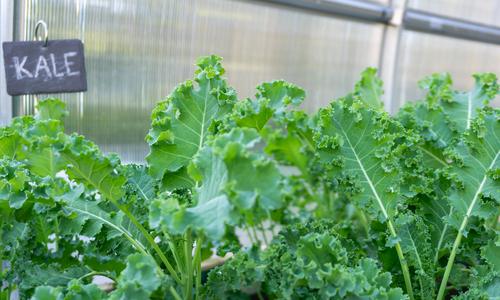
Kale growing in the community garden
So far Green Team members and volunteers have planted lettuce, kale, peppers, basil, cilantro, and thyme in the greenhouse. Agostini hopes to be able to harvest some greens and herbs by the beginning of B-Term.
Anyone who volunteers at the community garden during a given period will be able to take home part of the harvest, if they wish. Eventually, anything unclaimed after each harvest will be donated to DoughClub’s campus food pantry. And while hardy crops like kale should be able to keep growing in the unheated greenhouse through November and start growing again in late February or early March, harvests aren’t likely to be bountiful enough to share widely until the Green Team builds additional raised beds outside on the CRC lawn.
Next up for Green Team, now that the greenhouse is built and the first crops are beginning to thrive, is to expand and strengthen the garden community. In particular, Agostini is working with the Art and Design Club to highlight the interconnectedness of the WPI community while also sprucing up the concrete wall behind the greenhouse.
“We’re hoping to paint a nice mural that connects the CRC and ODIME’s mission of community building and multiculturalism to the garden’s mission of community building and giving back,” she says.
